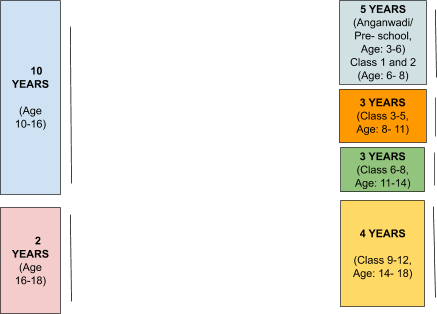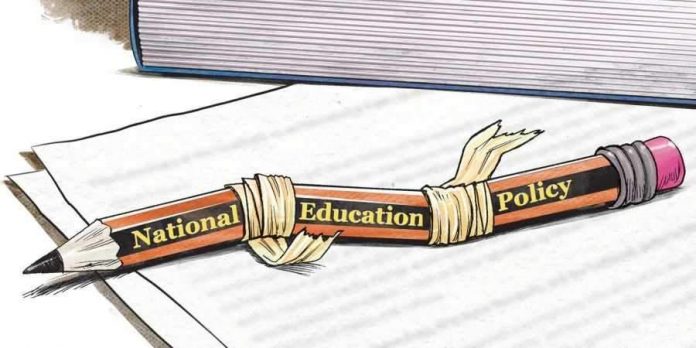This article is written by Shreya Tandon, from Vivekananda Institute of Professional Studies (VIPS), IP University, and Kumar Shubham, from NLU, Odisha. The article points out the new education policy introduced in 2020 that aims towards providing recommendations to the older reforms by opening the window of endless opportunities for students from the initial age and taking a notch towards educated and qualified India.
Table of Contents
Introduction
Only bookish language in exams may fetch you with good grades. But will not necessarily provide you with jobs and good intellectual knowledge. Quoting a very famous line from Gulzar’s song from the movie Mere Apne- “B.A. kiyaa, M.A. kiyaa, lagta hai woh bhi anwai kiya” (Despite having great degrees, everything seems to be futile).
Till the date, Indian education has been plagued by the ‘Russian Roulette’ examination system. Russian roulette is when you take a revolver, fill one of its chambers with a bullet, spinning the cylinder and pulling out the trigger while keeping its mouth on your head. The chances that one will survive are five out of six but that last will lead to a bullet in your head which is shot by you. Unfortunately, our exam system has become like this for ages which means you will pass, you may even get decent marks but if you don’t, you are out and you have a bullet in your head. Likewise, without even knowing the importance and having clarity in the subject matter, students were just expected to memorize the concepts and sit in the exam. Most of the students make it but the ones that don’t and flunk become history or maybe a footnote to history. But even if you are among the five lucky ones there is no guarantee that you’ll be placed in the best top shot places. In that case, where will you go with your marks?
Measures to overcome these loopholes in the education system were due for a long period. Finally, the union cabinet on 29th July, launched the new National Education Policy (NEP 2020) which aims to address many growing and developmental changes that are important for the country. The new policy proposes revising the decades old educational policy of India and revamp each and every aspect of the currently prevalent educational structure including its regulating and governing procedure, and to build a structure which is rightly in tune with the aspiring goals of the 21st century education system while keeping India’s traditions as well as its value systems in consideration. It is first such policy in Thirty-four years since the last changes in the education system were made in 1986. The Government claims that these changes will help transform India into a “Global knowledge Superpower”. The Government is aiming to introduce the new system in the upcoming session.
Background
The first education policy (NEP 1968) which was based on the recommendations of the Kothari commission, was introduced in the year 1968 by the Indira Gandhi Government This policy necessitated free and compulsory education for children up to age 14, as enshrined in the Constitution of India. The second education policy (NEP 1986) was introduced in the year 1986 by the Rajiv Gandhi Government. This policy aimed for removing disparities and provide equal education opportunity to everyone, especially to the Indian women and the Scheduled Tribe (ST) and Scheduled Caste (SC) people. The 1986 policy was later modified in the year 1992 by the P.V. Narshima Rao Government. After now after almost three decades, the Modi Government has introduced a new educational policy with a motive to revolutionize the Indian education system.
Previously, the Government began with the process of structuring a new education policy by the means of a consultation platform for an inclusive, participatory and holistic approach, and considering different expert opinions, empirical research works, field experiences, stakeholder feedback as well as the lessons learned from all best experiences. Keeping this in mind, a nine-member panel was framed and the former ISRO scientist, Krishnaswamy Kasturirangan was appointed the head of the panel. Experts from various fields were appointed into the panel by the Human Resource Development (HRD) Ministry. The committee submitted its report in May 2019 and the draft of the National Education Policy was uploaded on the website of the Human resource Development Ministry and other government portals to invite the views, suggestions and comments of different stakeholders, including the public. The draft of NEP was based on the fundamental pillars of access, equality, accountability, quality and affordability. It was also uploaded on MyGov portal and was open for public opinions.
After the submission of the draft report, the Governments of all the states/UTs and different ministries of the Indian Government were asked to give their opinions and commens on the draft of the National education Policy 2019. Also a briefly detailed summary of the proposed draft was then circulated among different stakeholders, and was translated in 22 different languages and uploaded on the Human Resource Ministry website. Certain meetings and educational dialogues with the State Secretaries of Higher & Technical Education and the State Education Secretaries of School Education were held. The policy underwent several examinations since then, including the latest modification of making it ready for an education system suitable with the current scenario of Covid-19 spread. Prime Minister Narendra Modi also reviewed the bill earlier in the month of May 2020 following which the bill was passed by the cabinet on 29th July.
Developments in the education system of India
|
Year of commencement |
Regulations |
|
1948- 1949 |
|
|
1952- 1953 |
|
|
1964- 1966 |
|
|
1968 |
National Policy on Education under the Indira Gandhi government |
|
1976 |
Education included in the concurrent list under 42nd Amendment |
|
1986 |
National Policy on Education (NPE) under the Rajiv Gandhi government |
|
1992 |
Program of Action (1986’s NPE modified) by the P.V. Narasimha Rao government |
|
2016 |
|
|
2019 |
|
|
2020 |
Vision of the National Education Policy
- An education system that contributes to an equitable and vibrant society, by providing high-quality education to all.
- Developing a deep sense of respect towards the fundamental rights, duties, and Constitutional values, bonding with one’s country, and conscious awareness of one’s role and responsibilities in a changing world.
- Instilling skills, values, and dispositions that support responsible commitment to human rights, sustainable development, and living and global well-being, thereby reflecting a truly global citizen.

Key changes brought in the NEP 2020
The National Education Policy is the new way of structuring the masterminds of incredible India. It is an initiative that gives importance not only to the nerd students but also to the creative minds of this new generation. With the changing centuries, comes the creativity and innovative skills which children possess, and to make efficient use of it so that the country can benefit from these skills, it is necessary to guide the students to the correct path right from their toddler age.
This policy was a much-awaited one but now it has finally come into action. Given below are the highlights of this policy as well as the criticism which concerned many people.
-
Restructuring of school structure

(Existing Academic Structure) (Revised Academic Structure)
-
- The 10+2 system is substituted with a 5+3+3+4 system. This pedagogical transformation aims at bringing multiple pathways to learning. This policy does not increase the number of years it just breaks down the existing structure and reframes it. The new structure is divided based on cognitive developmental stages that is, early childhood, school years, and secondary stage.
Stage 1: (5 years)
- It is given the name of the ‘Foundation stage’.
- Children of age group 3 to 8 fall in this category.
- It encompasses the first three years of a child at Anganwadi/preschool/ playschool and kindergarten catering up to 3 to 6 years of age.
- To the same set, children aged 6 to 8 years who will be in grades 1 or 2 are also added to keep pace with their language skills, basic concepts, and activity curriculum.
Stage 2: (3 years)
- It is categorized as the ‘Preparatory stage’.
- Includes students from classes third to fifth. Their age group varies from 8 to 11.
- From now onwards, more attention will be diverted to the cognitive development of the child starting from classroom activities to interactive classroom learning sessions to making them understand numeracy skills.
- Till class fifth, the medium of language between the student-teacher would either be a regional one or mother-tongue as decided by the state.
Stage 3: (3 years)
- This is regarded as the ‘Middle stage’.
- It came into play for students of classes sixth to eighth.
- Coding will be taught from class 6th onwards to develop critical thinking.
- Promote experiential learning, learning in sciences, mathematics, social studies, and arts.
- It discouraged rote learning and promoted analytical and critical development.
Stage 4: (4 years)
- It is the ‘Secondary stage’.
- It includes classes ninth to twelfth.
- It includes a multidisciplinary study where students can pick any combination of subjects they want.
-
No rigid separation between streams
- Arts, science, and commerce all of them are at an equal pace and now no distinction can be made in terms of choosing a particular set of subjects.
- The government will now follow a multidisciplinary approach. If a student wants to pursue fashion studies with chemistry or if one wants to learn mathematics with psychology, they’ll be allowed to do so.
- The neutral atmosphere amongst the students will not only provide them with the freedom to choose their subjects but will also eradicate the social- stigma attached to each stream.
- For example, students opting for medical and non-medical streams are looked up as geniuses by their peer group, whereas, students taking humanities are sometimes being mocked at, that they aren’t capable enough to understand the subjects like higher mathematics, accounts, and science and so on.
-
Mandatorily vocational studies to be made a part of the curriculum
- Indian education does not train you to do work with your hands and it only revolves around ‘completing the syllabus’.
- The purpose of strictly bringing up vocational education as a compulsory subject is to prepare people to work as a technician or an artist. It encourages a person to have an insight into his/her hidden talents which can make them not only successful but also satisfied in their lives.
- Vocational training includes engaging oneself in cross-occupational competencies such as working on communication skills, personality development, self- management skills, etc.
- Some of the examples of such skills are, learning pottery, carpentry, changing bulbs, farming, cooking, painting, hairdressing, tailoring, and many more.
-
The board exams will be at low stake
- Board exams from now onwards will check actual knowledge rather than rote learned concepts.
- Board exams will be comparatively made ‘easier’. It will test the competency of a child.
- Giving importance to viable modes, an examination will now take place in two parts- objective and subjective.
- The responsibility of preparing guidelines will now be given to NCERT in consultation with The State Council of Educational Research and Training (SCERTs), and Boards of Assessment (BoAs), and PARAKH.
- All subjects would be provided with two levels based on the difficulty that is the standard and the higher level. This is already being initiated in maths.
- By 2022-23, teachers have to be ready for a transformation in the assessment system.
- Every school board should make sure the equivalence of academic standards in learner’s attainments.
- Standards, norms, and guidelines for the school boards through PARAKH -National Center.
-
No bypassing of comprehensive education: Introduction of holistic progress card
- States/UTs have to redesign the report cards to make them 360 degrees holistic. They’ll no longer be only based on theoretical subjects but students will also be provided with ‘credit points’ for participating or engaging in co-curricular and extracurricular activities.
- Progress cards will include the assessment of self, teachers, and peers.
- Such cards will act as a progress meter for students that will reflect their potential and progress in the social-emotional, cognitive, and psychomotor skills.
- Active participation of the learner in debates, quizzes, sports, role plays, portfolios, and group activities will also be included.
- The above process will not only enhance the student-teacher relationship at a personal level but will also involve an acknowledgement of the child’s parents.
- Proper software will be developed to keep the whole record of the student’s curriculum which will also allow him to opt for a suitable career in the future.
-
Optimizing the cultural values by multilingualism
- One of the stated aims of the policy is to portray a “deep-rooted pride” in being Indian, not only in thought, but also in spirit, intellect, and deeds, as well as to develop knowledge, skills, values, and dispositions that support responsible commitment to human rights, sustainable development, and living and global well-being.
- The medium of education till 5th grade would be home language/ mother-tongue or any other local language.
- Every student has to take up a fun activity on the ‘Language of India’.
- The state/UTs will decide the three languages that would be taught to students.
- All classical languages would be given as an option to all the students. Sanskrit being one of the language formulas would be given more value in secondary and higher education.
- Sanskrit universities will now develop into multidisciplinary institutions.
- E-content to be available in 8 regional languages.
-
Single regulatory body
- The HRD ministry will now be called the Education ministry.
- 6% of the GDP to be allocated to the education sector.
- The UGC and AICTE will be merged to form a single regulator and will be called, Higher Education Commission of India (HECI).
- One common entrance exam for all higher education institutes to be conducted by NTA, it would be optional and would take place twice a year.
-
Foreign university campus will be set up in India
- Top 100 foreign colleges will be allowed to open branches in India.
- Indian SAT will be conducted.
- Many more undergraduate colleges will be given autonomy in their administrative and financial matters based on their accreditation.
-
Major reforms: Higher education
- The integration of UG and PG courses for a 5-year course can be considered.
- College credit transfer and academic bank of credit will also be considered.
- Plans are to include Undergraduate programs of three and four years and postgraduate programs of one and two years.
- The MPhil will be discontinued as a course. Institutions like IITs will be asked to become more holistic and have more courses on arts and humanities.
-
Efficient utilization of school space
- Use of school complexes beyond school hours and public library space for adult education courses which will be ICT- equipped.
- A sampling of important vocational crafts such as carpentry, electronic work, metalwork, and so on will be taught from grades sixth to eighth.
- Free boarding facilities will be built matching the standard of Jawahar Navodaya Vidyalayas particularly for students from socio-economically disadvantaged backgrounds.
Other major changes
- The policy also pitches for establishment of an Academic Bank of Credit which would digitally store the academic credits earned by the students, from different Higher Education Institutes (HEIs) so that the degrees from HEI can be awarded by taking the earned credits into account. There will be different Departments of languages, philosophy, music, art etc. Credits will be given in all Bachelor programmes for these subjects if they are done from such departments or through ODL mode when they are not offered in class at the HEI.
- An autonomous body, National Educational Technology Forum (NETF) will be created, which will provide a platform for exchange of views and ideas on how to use technology to enhance learning, assessment planning and so on for both schools and higher education universities. The NETF will have a permanent task to analyze and categorize emerging technologies in the field of education based on their potential, and to present it in front of the Education Ministry. Based on these inputs, the Ministry will then formally identify those technologies whose emergence demands for responses from the education system.
Paradoxical issues raised
- According to the NEP 2020, the children till class V will be taught in their home language or mother tongue. This raises a question on the medium of instruction: how will they be familiar with the English language which is spoken all over the world? India consists of the cosmopolitan population and people living here are also familiar with the various languages. If until the fifth standard, students are not made comfortable in speaking English, it will as a part of the medium of communication will go out of schools.
- Privatization and centralization of education are taking place as UGC and AICTE will be replaced by one common body. It will be a blow to the federal structure as only one body will operate it and the education sector will become a centre subject.
- Which body will be responsible for supervising that 6% of GDP is spent on real in the education sector. Currently, due to the COVID pandemic, the country is already facing crises. How can it afford to accommodate more money than before in education? This seems way too far to be accomplished as in 2008 only 0.86% of the GDP was invested in Research in higher education and innovation sector likewise the situation became worse in 2018 as only 0.06% of GDP was spent on Research in higher education and innovation.
- Despite such a positive step, no involvement of the Parliament was seen and it was completely bypassed. Neither there arose any debates nor any discussions.
Conclusion
The flaws in the education system vary from generation to generation and with the vintage of a person one asks. Some of the common complaints in the system are that degrees do not fetch you jobs, therefore, half of the population of people are tagged as ‘Unemployed educated youth’, India’s study pattern is more of rote learning and less of practical knowledge, most of the study is irrelevant in real lives, examination system is to exam- centric and so on. Now is the time to fix India’s wasteful degree exam disaster. Therefore, the Government of India introduced the new policy which includes various amendments in the present pattern.
The policy aims at making “India a global knowledge superpower”. The policy also aims at “light but tight” regulation by a single regulator for higher education as well as increased access, equity, and inclusion.
References
- https://www.hindustantimes.com/education/new-education-policy-2020-live-updates-important-takeaways/story-yYm1QaeNyFW4uTTU3g9bJO.html#highlight12
- https://www.financialexpress.com/education-2/new-education-policy-is-a-great-opportunity-to-define-history/1609431/
- https://www.indiatoday.in/education-today/featurephilia/story/liberalizing-indian-education-how-modi-s-new-education-policy-nep-can-give-a-new-shape-to-india-s-education-sector-1554947-2019-06-24
- https://economictimes.indiatimes.com/news/politics-and-nation/rss-affiliates-welcome-the-nep-say-over-60-of-their-suggestions-met/articleshow/77249418.cms
- https://timesofindia.indiatimes.com/city/delhi/experts-differ-over-focus-on-vocational-edu-in-schools/articleshow/77250784.cms
- https://www.hindustantimes.com/education/new-education-policy-2020-board-exams-set-to-be-easier-as-nep-moots-lowering-stakes/story-zs74dFsA9yPZhgR4MaV6TM.html
- https://www.ndtv.com/india-news/national-education-policy-nep-2020-mother-tongue-till-class-5-10-points-on-national-education-policy-2020-2270926#:~:text=The%20mother%20tongue%20or%20local,from%20the%20secondary%20school%20level.
- https://timesofindia.indiatimes.com/india/less-stress-on-boards-common-college-entrance-test-in-sweeping-education-reforms/articleshow/77250887.cms
- https://www.thehindu.com/news/cities/bangalore/new-education-policy-revives-debate-on-medium-of-instruction/article32224518.ece#:~:text=With%20the%20new%20National%20Education,again%20cropped%20up%20in%20Karnataka.&text=Following%20this%20court%20order%2C%20private,medium%20classes%20in%20primary%20schools.
- https://www.ndtv.com/education/national-education-policy-2020-ugc-aicte-naac-be-merged-in-new-body
- https://theprint.in/india/education/a-second-shot-at-boards-no-mphil-a-blow-to-rote-learning-what-modi-govts-nep-brings/470725/
- https://www.indiatvnews.com/education/news-coding-from-class-6-modi-government-new-education-policy-638043
LawSikho has created a telegram group for exchanging legal knowledge, referrals and various opportunities. You can click on this link and join:
 Serato DJ Crack 2025Serato DJ PRO Crack
Serato DJ Crack 2025Serato DJ PRO Crack










 Allow notifications
Allow notifications



